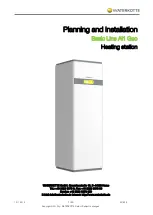
SOLENOID
BRACKET
BALL
JOINT
LOCK NUT
IDLER
ROD
FIGURE F.2 – ENGINE COMPONENTS (CODE 11199 & 114080)
ENGINE RPM ADJUSTMENT TEST (continued)
Strobe-Tach Method (continued)
5. The tach should read between 1780 and 1810 RPM
6. Move the idle switch to the “AUTO IDLE” position
and wait for the idle solenoid to energize, and the
engine RPM to drop and stabilize at the low idle
RPM.
7. Synchronize the strobe-tach to read the low idle
RPM.
8. The tach should read between 1000 and 1150
RPM.
9. If either of the readings is incorrect, proceed to the
“ENGINE RPM ADJUSTMENT PROCEDURE” later
in this section.
Frequency counter method:
NOTE:
A dedicated frequency counter can be used for
this test, but many high quality digital multime-
ters also have this function, and can be easily
utilized. See the manufacturer’s instructions
for your frequency counter or multimeter.
1. Set your frequency counter per the meter manufac-
turer’s instructions, and plug the probes into one of
the 120VAC auxiliary receptacles.
2. Start the engine and place the idle switch in the
“HIGH IDLE” position. Apply a resistive load of
about 300 amps long enough to get the machine up
to operating temperature and the RPM to stabilize.
CAUTION: Do Not Short the Output Studs Together
as a means of loading the machine.
Serious damage can result that will not
be covered by Warranty
The frequency should read between 59.3 and 60.3 Hz.
Move the idle switch to the “AUTO IDLE” position and
wait for the idle solenoid to energize, and the engine
RPM to drop and stabilize at the low idle RPM.
The frequency should read between 33.3 and 38.3Hz.
If either of the readings is incorrect, proceed to the
“
ENGINE RPM ADJUSTMENT PROCEDURE
” later in
this section.
NOTE:
For the SAE-400 Severe Duty, and any other
Lincoln Electric 1800 RPM (4 Pole) machine,
that has 60 Hz AC auxiliary power; the engine
RPM can be determined by multiplying the fre-
quency of the auxiliary power output, in Hz. By
30. (Example: 60 Hz. * 30 = 1800 RPM)
TROUBLESHOOTING AND REPAIR
F-23
F-23
SAE-400 SEVERE DUTY
Return to Section
T
OC
Return to Section
T
OC
Return to Section
T
OC
Return to Section
T
OC
Return to Master
T
OC
Return to Master
T
OC
Return to Master
T
OC
Return to Master
T
OC















































